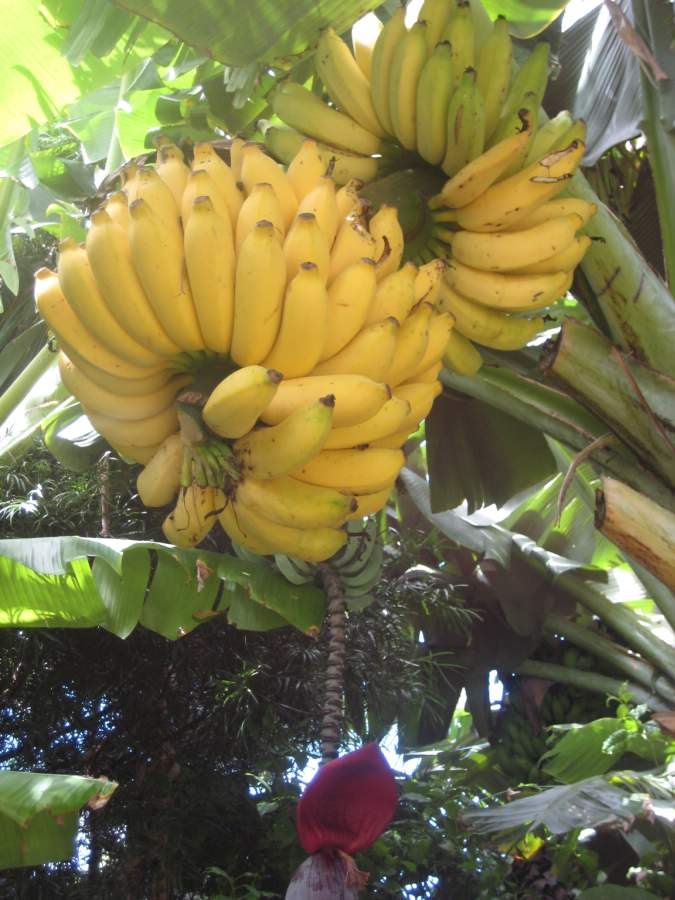Air Temperatures – The following maximum temperatures were recorded across the state of Hawaii Thursday:
Lihue, Kauai – 80
Honolulu airport, Oahu – 83 (Record high temperature for Thursday – 87 / 1974)
Kaneohe, Oahu – 81
Molokai airport – 79
Kahului airport, Maui – 81
Kona airport – 82
Hilo airport, Hawaii – 77
Air Temperatures ranged between these warmest and coolest spots near sea level – and on the highest mountain tops…as of 5pm Thursday evening:
Barking Sands, Kauai – 80
Kapalua, Maui – 72
Haleakala Crater – 41 (near 10,000 feet on Maui)
Mauna Kea – 28 (near 13,800 feet on the Big Island)
Hawaii’s Mountains – Here’s a link to the live web cam on the summit of near 13,800 foot Mauna Kea on the Big Island of Hawaii. This web cam is available during the daylight hours here in the islands…and when there’s a big moon shining down during the night at times. Plus, during the nights you will be able to see stars, and the sunrise and sunset too…depending upon weather conditions. Here's the Haleakala Crater webcam on Maui…although this webcam is not always working correctly.
Aloha Paragraphs

Locally gusty trades – windward showers at times, with
localized leeward showers here and there as well
As this weather map shows, we have a near 1035 millibar high pressure system far to the north of Hawaii, with its associated ridge to the northwest through west of the islands. Our local winds will remain moderately strong and gusty into the weekend…and beyond.
The following numbers represent the most recent wind gusts (mph), along with directions as of Thursday evening:
18 Lihue, Kauai – NE
27 Honolulu, Oahu – NE
28 Molokai – NE
35 Kahoolawe – ESE
35 Kahului, Maui – NE
20 Lanai – NE
25 South Point, Big Island – NE
We can use the following links to see what’s going on in our area of the north central Pacific Ocean. Here's the latest NOAA satellite picture – the latest looping satellite image…and finally the latest looping radar image for the Hawaiian Islands.
Here are the latest 24-hour precipitation totals (inches) for each of the islands as of Thursday evening:
1.58 Mount Waialeale, Kauai
0.36 Oahu Forest NWR, Oahu
0.04 Molokai
0.01 Lanai
0.01 Kahoolawe
1.81 Puu Kukui, Maui
0.63 Waiakea Uka, Big Island
Sunset Commentary: There will be small fluctuations in trade wind speeds, although they will continue to blow well into the future. They will be strongest around Maui County and the Big Island, thus the small craft wind advisory continues around parts of those eastern islands Thursday evening, which will likely continue to be posted through the day Friday into Saturday morning. These trade winds will carry showers into the windward sides at times. The leeward sides in contrast should remain drier, although a few showers will fall in these areas on the smaller islands locally as well.
Here in Kula, Maui at 530pm, skies were partly cloudy, with light winds and an air temperature of 67.8F degrees. As noted above, our trade winds will persist through the rest of this week, into next week…matching climatology well. As for precipitation, there will be some showers along the windward sides in an off and on manner. Speaking of which, and as this satellite image shows, there are quite a few shower bearing clouds just upstream of the islands again this evening…which will be carried into our windward sides tonight into Friday. Showers fell at times along our windward sides, especially around Maui County and the Big Island during the day. At one point this morning, a quick shower broke out here in Kula, which was a bit unusual. Typically, if we're going to get showers here on the leeward slopes of the Haleakala Crater, they arrive during the afternoon hours this time of year. I was just out in the garden now, and we had a second shower of the day. Looking over towards Pukalani, Makawao, Paia and Haiku, it sure does look showery over there just before sunset too! In sum, the trades will continue, with more than the ordinary amount of showers along our windward coasts and slopes for the time being. The computer models are suggesting that we should turn a bit drier along those north and east facing sides of our islands this weekend. ~~~ I'll be back early Friday morning with your next new weather narrative from paradise. I hope you have a great Thursday night until then! Aloha for now…Glenn.
Interesting: The reappearance of long-forgotten habitats and the resurgence of species unseen for years may not be among the expected effects of a natural disaster. Yet that's exactly what researchers have found on the sandy beaches of south central Chile, after an 8.8-magnitude earthquake and devastating tsunami in 2010. Their study also revealed a preview of the problems wrought by sea level rise — a major symptom of climate change.
In a scientific first, researchers from Universidad Austral de Chile and UC Santa Barbara's Marine Science Institute (MSI) were able to document the before-and-after ecological impacts of such cataclysmic occurrences. A new paper appearing in the journal PLoS ONE elucidates the surprising results of their collaborative study, pointing to the potential effects of natural disasters on sandy beaches worldwide.
"So often you think of earthquakes as causing total devastation, and adding a tsunami on top of that is a major catastrophe for coastal ecosystems. As expected, we saw high mortality of intertidal life on beaches and rocky shores, but the ecological recovery at some of our sandy beach sites was remarkable," said Jenifer Dugan, an associate research biologist at MSI."
Dune plants are coming back in places there haven't been plants, as far as we know, for a very long time. The earthquake created sandy beach habitat where it had been lost. This is not the initial ecological response you might expect from a major earthquake and tsunami."
Their findings owe a debt to serendipity. With joint support from Chile's Fondo Nacional de Desarrollo Científico y Tecnológico and the U.S. National Science Foundation's Long Term Ecological Research program, the scientists were already knee-deep in a collaborative study of how sandy beaches in Santa Barbara and south central Chile respond, ecologically, to human-made armoring such as seawalls and rocky revetments.
As part of that project, the Chilean team surveyed nine sandy beaches along the coasts of Maule and Bíobío in late January, 2010. The earthquake hit in February. Realizing their unique opportunity, the scientists quickly changed gears and within days were back on the beaches to reassess their study sites in the catastrophe's aftermath.
They have returned many times since, diligently documenting the ecological recovery and long-term effects of the earthquake and tsunami on these coastlines, in both natural and human-altered settings. The magnitude and direction of land-level change brought the greatest impact, drowning beaches especially where the tsunami exacerbated earthquake-induced subsidence — and widening and flattening beaches where the earthquake brought uplift.
The drowned beach areas suffered mortality of intertidal life; the widened beaches quickly saw the return of plants and animals that had vanished due to the effects of coastal armoring. "With the study in California and our study here, we knew that building coastal defense structures, such as seawalls, decreases beach area, and that a seawall results in the decline of intertidal diversity," said lead author Eduardo Jaramillo, of Universidad Austral de Chile.
"But after the earthquake, where significant continental uplift occurred, the beach area that had been lost due to coastal armoring has now been restored. And the re-colonization of the mobile beach fauna was under way just weeks after."
With responses varying so widely depending on land-level changes, mobility of flora and fauna, and shore type, the findings show not only that the interactions of extreme events with armored beaches can produce surprising ecological outcomes — but also suggest that landscape alteration, including armoring, can leave lasting footprints in coastal ecosystems.
"When someone builds a seawall, not only is beach habitat covered up with the wall itself, but, over time, sand is lost in front of the wall until the beach eventually drowns," Dugan said. "The semi-dry and damp sand zones of the upper and mid intertidal are lost first, leaving only the wet lower beach zones. This causes the beach to lose diversity, including birds, and to lose ecological function.
This is an underappreciated human impact on coastlines around the world, and with climate change squeezing beaches further, it's a very serious issue to consider." Jaramillo elaborated, "This is very important because sandy beaches represent about 80 percent of the open coastlines globally. Also, sandy beaches are very good barriers against the sea level rise we are seeing around the world.
It is essential to take care of sandy beaches. They are not only important for recreation, but also for conservation." The study is said to be the first-ever quantification of earthquake and tsunami effects on sandy beach ecosystems along a tectonically active coastal zone.












 Email Glenn James:
Email Glenn James:
Justin Gilliland Says:
The single biggest source of air pollution on Maui is the sugar cane fields and other things sprayed into the sky ~~~Thanks Justin, Aloha, Glenn
Mike Says:
Aloha Glenn
You write: "I'm a bit uncertain about what all the haze is that's in our atmosphere now. I can't visually see the rest of the state obviously, although here on Maui it sure looks like volcanic haze to me. As the winds are coming in from the trade wind direction, rather than the southeast, it has be scratching my head, and I don't have a good answer for it."
Do you think maybe this haze is dust from the annual Gobi dust storm that has been carried aloft to our East and now is settling down and scattered by the Trades?
There was a huge dust plume over the Western Pacific a few days ago. Maybe it has made it to Maui? Your thoughts are appreciated:
http://www.westernpacificweather.com/2012/04/29/a-mixed-bag-of-weather-as-yellow-sand-blows-out-of-the-gobi-and-storms-erupt-in-south-east-china/
As always, thanks for all the great info! -mike~~~Hello Mike, thanks for your comment. Honestly, I don’t know what the source of our hazy skies are at the moment, as I mentioned. Looking down the mountain now, mid-morning Monday, it doesn’t look as hazy as it did yesterday or earlier this morning. As to those other sources of dust or haze you brought forward above, I still couldn’t say for sure. It’s interesting for sure, and perhaps I was a bit too “quick on the draw”, in suggesting volcanic haze. I sometimes see marine haze, although typically that is when the surf is large, and lots of salt spray is being thrown into the air by the breaking waves on our north shores. So, I’d like to throw it up for all educated guesses, or suggestions on what it might be. Aloha, Glenn